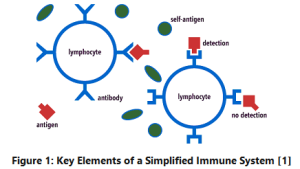Asst. Prof. Dr. Noor D. Al-Shakarchy
Department of Computer Science, Faculty of Computer Science and Information Technology
Artificial immune systems (AIS) is a subfield of artificial intelligence (AI) inspired by the biological immune system. The goal of AIS is to develop computational models and algorithms that can mimic the functions of the natural immune system and apply them to solve complex problems in various fields, including optimization, pattern recognition, data mining, and anomaly detection.
The natural immune system is a highly adaptive and robust system that can detect and respond to foreign agents in the body in order to defend the body against invading pathogens, such as bacteria, viruses, and cancer cells by identifying and eliminating them. It accomplishes this task by recognizing foreign antigens and producing antibodies that can specifically bind to them. The key elements of a highly simplified immune system are illustrated in Figure 1

In soft computing, AIS algorithms are used to mimic the processes of the immune system and apply them to various problem domains by using similar mechanisms. The AIS algorithms are highly adaptive, robust, and capable of handling large data sets, making them valuable tools for a wide range of applications in various fields of real life, including data mining, optimization, classification, and bioinformatics. Some of the main applications of AIS are:
- Anomaly detection: AIS algorithms can be used to detect anomalies in data sets that may indicate the presence of a threat or an error. These algorithms can identify unusual patterns and flag them for further investigation. AIS-based anomaly detection has applications in fraud detection, network intrusion detection, and medical diagnosis.
- Pattern recognition: AIS algorithms can be used to identify patterns in large data sets. They use the immune system’s ability to recognize and respond to antigens to identify patterns in data and classify them accordingly. Applications of AIS-based pattern recognition include image recognition, speech recognition, and bioinformatics.
- Optimization: AIS algorithms can be used to optimize complex systems by mimicking the immune system’s ability to adapt to changing conditions. For example, AIS can be used to optimize the routing of vehicles in a logistics network, to optimize the design of chemical processes, or to optimize the parameters of a machine learning model.
- Clustering: AIS algorithms can group data points into clusters based on their similarity. This can be useful in applications such as market segmentation or customer profiling.
- Robotics: AIS algorithms can be used to control the behaviour of robots by mimicking the immune system’s ability to adapt to changing environments. Applications of AIS-based robotics include swarm robotics, robot navigation, and robot control.
- Biomedical applications: AIS has several applications in bioinformatics, such as antibody design, vaccine design, and drug discovery.
Artificial immune systems in the COVID-19 pandemic
Artificial immune systems (AIS) have several potential applications in addressing the pandemics such as the COVID-19 pandemic. Some ways AIS can be used to help with COVID-19 are:
- Vaccine design: AIS algorithms can be used to design vaccines that target specific antigens in the virus. By simulating the immune system’s ability to recognize and respond to antigens, AIS algorithms can help identify the most effective targets for a vaccine.
- Drug discovery: AIS algorithms can be used to identify potential drug candidates that can disrupt the virus’s ability to infect host cells. By simulating the immune system’s ability to recognize and destroy pathogens, AIS algorithms can help identify compounds that can interfere with the virus’s life cycle.
- Diagnosis: AIS algorithms can be used to analyze medical data and identify patterns that may indicate a COVID-19 infection. By simulating the immune system’s ability to recognize and respond to antigens, AIS algorithms can help identify the presence of the virus in patient samples.
- Surveillance: AIS algorithms can be used to monitor the spread of the virus and predict its future trajectory. By simulating the immune system’s ability to detect and respond to threats, AIS algorithms can help predict the likelihood of future outbreaks and inform public health decisions.
- Resource allocation: AIS algorithms can be used to optimize the allocation of resources, such as hospital beds and ventilators, during the pandemic. By simulating the immune system’s ability to adapt to changing conditions, AIS algorithms can help allocate resources where they are most needed.
Overall, AIS has shown promising results in a variety of applications, including network intrusion detection, image recognition, and optimization problems. However, like all AI techniques, AIS has its limitations and is not a universal solution for all problems.
Reference
James McCaffrey, Test Run – Artificial Immune Systems for Intrusion Detection, ⦁ MSDN Magazine Issues, Volume 28 Number 01, January 2013
Ying Tan, Artificial Immune System: Applications in Computer Security, Wiley-IEEE Computer Society, ISBN: 978-1-119-07628-5, June 2016.
Dipankar⦁ ⦁ Dasgupta, Artificial Immune Systems and Their Applications, springer link, 1999.
Christian Jacob, et. al, Artificial Immune Systems: 4th International Conference, ICARIS 2005, Banff, Alberta, Canada, August 14-17, 2005, Proceedings (Theoretical Computer Science and General Issues, 3627), Springer; 2005th edition (August 4, 2005).
Hongwei⦁ Mo, Handbook of Research on Artificial Immune Systems and Natural Computing: Applying Complex Adaptive Technologies; ISBN-13. 978-1605663104; Medical Information Science Reference, December 16, 2008. DOI: 10.4018/978-1-60566-310-4.


























































